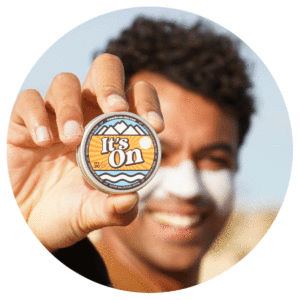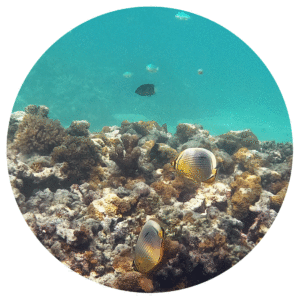IT'S ON ZINC SUN PROTECTION - FAQ

What is mineral sun protection / zinc sun protection?
Put simply, mineral sun protection represents a barrier to the sun’s rays (UV radiation). This means, the skin must be well covered with a thick layer. This covering layer reflects and absorbs part of the incoming ultraviolet rays .
The less UV radiation penetrates the protective barrier and reaches the skin, the higher the protection (sun protection factor) actually is.
The best-known mineral UV filters are titanium dioxide and zinc oxide.
However, since studies suggest that titanium dioxide is hazardous to health, we only use zinc oxide for It’s On.
Good to know: The combination of chemical and mineral filters appears to significantly reduce the protective effect against UV radiation. Therefore, either use sunscreen with chemical filters OR mineral sunscreen.
What is the sun protection factor (SPF)?
The sun protection factor is the indicator for protection against striking UV-B radiation. It indicates how much longer you can stay in the sun without getting sunburned, than this would be the case without sun protection.
SPF 15 means you can stay 15 times longer in the sun without getting sunburned than you could stay without protection. SPF 30 corresponding to 30 times etc.
By definition, a certain filter property for UV-B radiation is attributed to the sun protection factor. Expressed as a percentage, it looks like this:
- SPF 15 will block approximately 93% of the UV-B rays that hit it
- SPF 20 will block approximately 95% of the UV-B rays that hit it
- SPF 30 will block approximately 97% of the UV-B rays that hit it
- SPF 50 will block approximately 98% of the UV-B rays that hit it
However, the LSF cannot be expanded at will. There is no such thing as 100% protection. It is therefore very important to allow the skin to regenerate in the shade after a longer stay in the sun.
Since some of the radiation will always break through the barrier when being in the sun, it is a fallacy to believe that the protection can be extended at will through repeated use. Sooner or later, a critical dose of radiation will be reached, and the visible sign will be reddening of the skin (sunburn).
The LSF only provides information about protection against incoming UV-B radiation. Among other things, this is responsible for the occurrence of sunburn and is only part of the striking ultraviolet radiation.
What is UV-A & UV-B radiation?
UV-A and UV-B are portions of ultraviolet radiation that have different effects, but both are potentially dangerous to us. The skin and eyes are particularly affected.
- UV-A penetrates deeper into the skin and can potentially promote skin cancer.
- UV-B penetrates less deeply, can cause sunburn and damage the skin, but it is also responsible for the formation of vitamin D.
Smart sun protection must therefore reliably filter both UV-A and UV-B and thus prevent damage to the skin.
In addition to the SPF, there is also the UV-A label. Sun protection products must achieve at least 1/3 of the SPF in the UV-A range in order to be allowed to carry this. With SPF 30, at least UV-A protection of 10 must be achieved. Of course, it is ideal if a high level of protection is offered in both areas.

What is zinc oxide?
Zinc oxide is a so-called broadband filter with reliable protection against UV-A and UV-B radiation. The filter effect in the UV-A range tends to be even a little higher than in the UV-B range, but overall the entire UV spectrum is reliably covered. For this reason, Zinc Oxide is particularly suitable for use in sun protection products and is our filter of choice for It’s On.
Zinc oxide is also a natural bright white color pigment. This means, that using zinc oxide in pastes and creams will cause the product being bright white. To avoid this effect, some manufacturers use zinc oxide in the form of nanoparticles. These tiny particles are transparent and therefore supposedly more attractive than the white pigments. The main disadvantage is that these tiny nanoparticles can penetrate our skin or corals and damage them.
There are studies that prove this damage and vice versa studies that show that nanoparticles are harmless. We don’t want to get involved in this dispute, but we do have an opinion on it. We believe that it is not good to expose people and nature to the risk of nanoparticles. It is therefore clear to us that we do not use any nanoparticles for It’s On.
But we also do believe that you don’t necessarily have to wear white make-up on your face to protect yourself from UV radiation. For that reason we add a little pigment to It’s On. By doing so, we achieve a subtle brown coloring of the paste.


How to apply It's On zinc paste?
The zinc paste must be applied to the skin as a well covering layer. The full protective effect can only be achieved if the skin is actually covered opaque. For that reason you should definitely apply thickly here. To achieve this, the required amount of zinc paste must be taken out of the can and then spread on the skin.
The best way to do this is to get the zinc paste out of the can with your fingernail. It makes sense to move the nail away from the body. In this way you can prevent residues of the zinc paste from sticking under your fingernail.
What is is the sun protection factor of It's On zinc paste?
With zinc paste, the sun protection factor depends directly on the thickness of the applied layer. The thicker the cover, the higher the protection!
However, it must be noted that complete protection is not possible. No matter how thick the paste is applied, complete shielding of the skin is not possible.
With an opaque cover, the SPF is 30. It decreases significantly (approx. SPF 15) if the paste is applied very thinly. This is also the case, for example, if the paste is gradually rubbed off during sport. This decrease in protection is related to the fact that a higher percentage of UV radiation can penetrate the barrier when it is thinner.
The balanced protection against UV-A and UV-B radiation deserves special mention. It’s On zinc paste protects against UV-A and UV-B in almost the same ratio.


Ocean & Reef safe
Even though more and more manufacturers – including us – are advertising with the “ocean & reef safe” label, there is currently no generally valid or officially recognized test procedure in which this is tested and certified.
Conversely, however, it is very well documented that some chemical UV filters (e.g. oxybenzone or octinoxate) and also very small particles of mineral filters (nanoparticles) can harm reefs and marine life.
For this reason, specific UV filters have already been banned in some countries (e.g. Hawaii and the Virgin Islands).
Based on current knowledge, mineral sun protection such as our It’s On zinc, which does NOT use NANOPARTICLES, can be considered the best choice for oceans and reefs and is labeled as ocean & reef safe.

What is titanium dioxide?
Titanium dioxide is a mineral UV filter and can be used as sun protection. It has even better filter properties than zinc oxide in the UV-B radiation range, but filters less strongly in the UV-A range. For this reason, it is often used as a supplement to zinc oxide. Compared to this, however, the titan is problematic. There are studies that classify titanium dioxide as hazardous to health. It’s not just about the application for the end user, but also about the processing. In particular, inhalation is considered carcinogenic and is therefore highly problematic. In addition, the European Commission has issued a ban on the use of titanium dioxide as a food additive. For this reason we do not use titanium dioxide for It’s On.

References:
Curtis Cole, C., Shyr, Th. & Ou-Yang, H. (2015): Metal oxide sunscreens protect skin by absorption, not by reflection or scattering
EFSA (2021): Titandioxid: E171 gilt bei Verwendung als Lebensmittelzusatzstoff nicht mehr als sicher
EPA: Health Effects of UV Radiation
European Commission, Health & Consumers (2012): Details on zinc oxide
Europäische Kommission (2022): Titandioxid in Lebensmitteln ab Sommer 2022 verboten
Deutsche Stiftung Meeresschutz (2023): Was ist korallenfreundlicher Sonnenschutz?
Schneider, S. L. & Lim, H. W. (2018): A review of inorganic UV filters zinc oxide and titanium dioxide.
Tech Times (2017): Food Additive Under Review After Study Finds Cancer Links In Animal Study
Zentrum der Gesundheit (2021): Titandioxid – Ein Stoff, den Sie meiden sollten
Pharmazeutische Zeitung (2021): Bildung krebserregender Stoffe. Alte Sonnencreme besser nicht mehr benutzen
PTA heute (2022): Zinkoxid nicht mit chemischen UV-Filtern mischen


